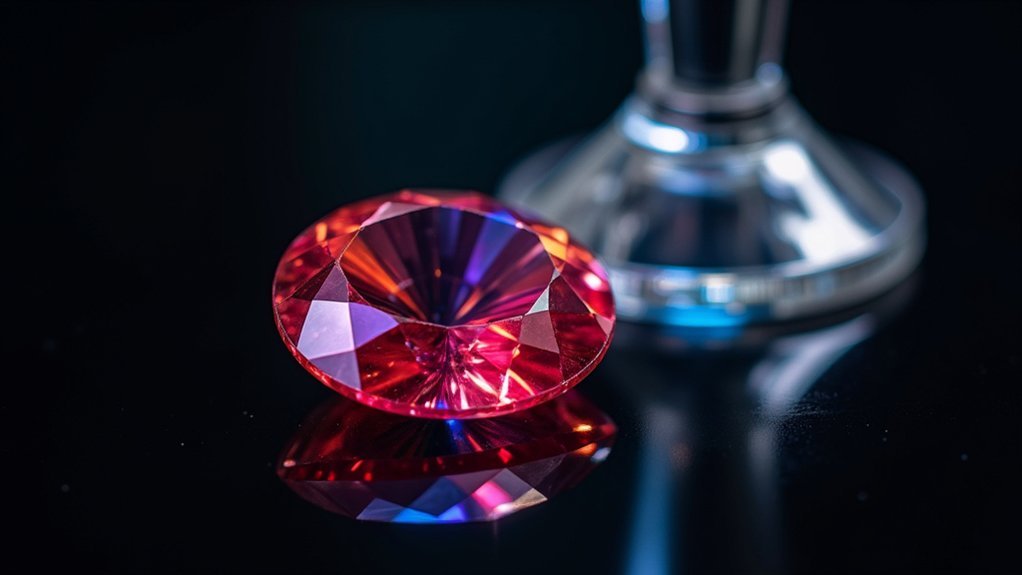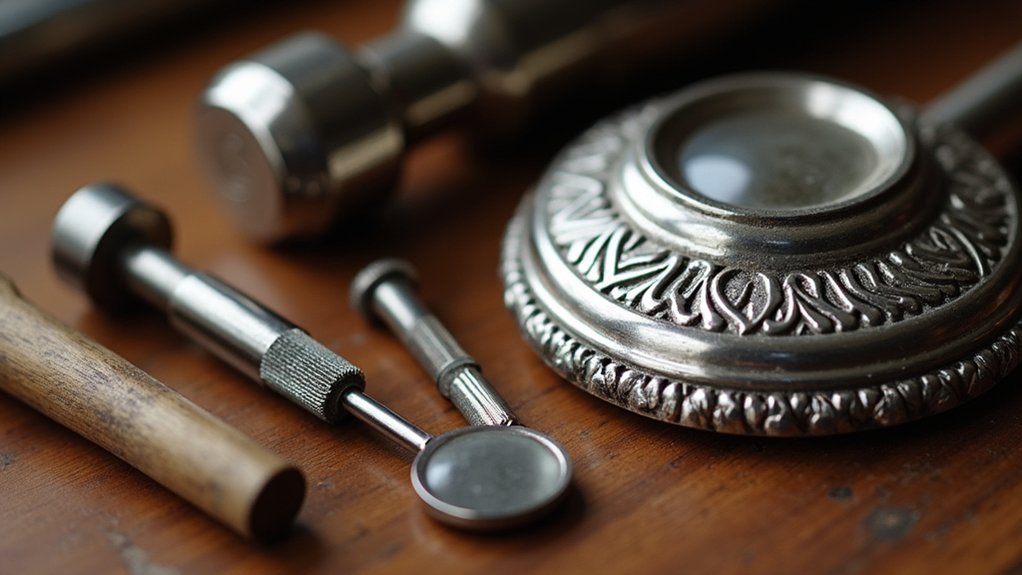When testing gemstones with a dichroscope, you’ll get best results by using strong white light positioned at 90 degrees behind the stone. Always rotate stones exactly 180 degrees to observe color changes, and test from multiple angles including girdle, table, and side facets. This technique helps distinguish singly refractive stones (one color) from doubly refractive ones (two colors). Document your observations systematically, noting color strength and variations. These proper techniques will transform your gemstone identification accuracy.
Mastering the Proper Lighting Setup for Accurate Dichroscope Readings

While many aspects of gemstone testing require precision, nothing impacts dichroscope readings more profoundly than proper lighting.
The foundation of accurate gemstone analysis lies in precision lighting—the critical factor that makes or breaks your dichroscope readings.
You’ll need a strong white light source—preferably LED or halogen—positioned behind the gemstone at a 90-degree angle for ideal color observation. This positioning guarantees pleochroic colors appear distinctly in your dichroscope.
Avoid fluorescent lighting, which produces misleading readings that can compromise your gemstone testing results. Instead, create a controlled lighting environment that minimizes external light interference, allowing for accurate readings of the stone’s true colors.
Don’t hesitate to experiment with different light source angles, as orientation considerably affects how pleochroic colors manifest.
Your lighting setup remains the foundation for reliable dichroscope analysis, so prioritize getting this element right before proceeding.
The 180-Degree Rotation Method for Detecting Subtle Pleochroism
Once you’ve established the ideal lighting setup, the 180-degree rotation method becomes your next powerful technique for dichroscope analysis. This approach lets you detect subtle pleochroism that might otherwise go unnoticed during gemstone testing.
To execute this method effectively:
- Rotate the gemstone exactly 180 degrees while looking through the dichroscope.
- Carefully note any color changes in hue or intensity during rotation.
- Examine from multiple angles, particularly at girdle and table facets.
- Document all observed colors to help distinguish similar gems like garnets from tourmalines.
- Compare colors in different orientations to determine the strength of pleochroism.
This systematic rotation approach helps you as a gemologist make accurate classifications by revealing distinctive optical properties that characterize various gemstone species.
Three-Angle Testing Strategy for Comprehensive Color Analysis

After mastering basic dichroscope techniques, you’ll need a systematic approach to fully analyze pleochroic gemstones. The three-angle testing strategy examines the stone from multiple perspectives: the girdle, table, and two side top facets.
Master the three-angle testing strategy to fully analyze pleochroic gemstones from every critical perspective.
For accurate gemstone identification, position your dichroscope at each angle while using a strong white light source. Rotate the stone 180 degrees between observations to detect changes in color intensity and hue. These variations confirm pleochroism’s presence and strength.
When testing gemstones, document the colors observed at each position. This thorough color analysis creates a complete picture of the stone’s pleochroic properties.
Your records will prove invaluable when determining ideal cutting orientation to either maximize or minimize color variations, depending on your desired result.
Distinguishing Between Singly and Doubly Refractive Gemstones
The dichroscope reveals one of gemology’s fundamental distinctions: whether a stone is singly or doubly refractive. When you’re conducting gemstone testing, place the stone’s girdle near the dichroscope’s aperture and rotate it slowly. Singly refractive stones like garnets display only one color, while doubly refractive gems show two distinct colors as they split light rays.
- Optical-grade calcite in dichroscopes enables clear visualization of pleochroic colors
- Test from multiple angles to confirm your classification with certainty
- Singly refractive stones maintain consistent coloration regardless of viewing position
- Doubly refractive gems like tourmalines exhibit varying colors when rotated
- The presence of pleochroism helps identify specific gem varieties within doubly refractive categories
This optical property testing is essential for accurate gemstone identification when other characteristics appear similar.
Documenting Dichroscope Results for Better Gem Identification

Systematic documentation of dichroscope observations transforms casual gemstone testing into scientific identification.
When recording your testing results, always note the strength and variation of pleochroic colors you observe, as these directly indicate specific gemstone properties.
Include the angles at which color changes occur, providing valuable information for ideal cutting orientation.
Recording precise angles of pleochroic shifts guides optimal faceting decisions for maximum color display.
Don’t overlook details about your light source—fluorescent lighting can produce significantly different results than natural light.
Maintain consistency by using a chart or table format for your documentation, allowing you to quickly compare findings across multiple specimens.
This organized approach highlights subtle differences between similar gemstones.
Review your documented observations regularly to identify patterns that enhance your gemstone identification skills and build a personal reference library of dichroscope results.
Frequently Asked Questions
How Do You Identify a Gemstone With a Dichroscope?
You’ll identify a gemstone by placing its girdle near the dichroscope aperture with strong backlighting, observing color differences in the two squares, and rotating the stone to detect pleochroism characteristic of specific gems.
What Is the Best Tool to Test Gemstones?
The dichroscope is your best tool for testing gemstones. It reveals pleochroism, showing color variations in doubly refractive stones. You’ll need a strong white light to see these differences effectively.
What Is the Best Way to Test Gemstones?
You’ll need multiple tests for accurate gemstone identification. Use a refractometer for refractive index, specific gravity testing, magnification for inclusions, spectroscope for absorption patterns, and polariscope for optical properties determination.
What Is the Difference Between Calcite Dichroscope and London Dichroscope?
Calcite dichroscopes use natural crystals for clearer color separation while London dichroscopes use polarizing filters. You’ll find the calcite version offers better accuracy, but London’s design is more portable for your fieldwork.
In Summary
You’ve now explored the five essential dichroscope techniques that will transform your gemstone testing capabilities. By mastering proper lighting, the 180-degree rotation method, three-angle testing, refraction distinction, and result documentation, you’ll confidently identify gems that others might misclassify. Remember, it’s your consistent practice with these methods that’ll ultimately sharpen your skills and enhance your expertise in gemology. Start implementing these techniques today!





Leave a Reply